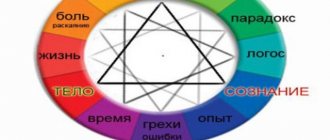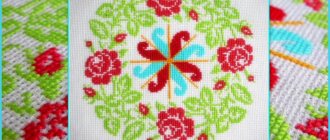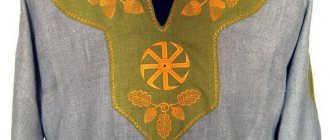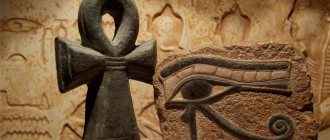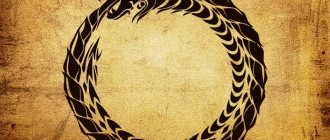From this article you will learn:
- What is occultism
- What are the most common symbols of the occult?
- Where are occult symbols used?
- Where can you purchase occult symbols for rituals and everyday life?
Mystical symbols of the occult in most existing religions are identified with negativity and prohibition, and they arouse both great interest and fear among people. You can find them in the form of images on walls and decorations or as an element of clothing. So what is occultism, what do these symbols mean, what secret is hidden in them?
#10 Ankh Symbol (Ankh)
The Ankh talisman is an ancient Egyptian hieroglyphic symbol that was most often used in writing and art to describe the word "life". He also personified insight and wisdom at the highest level.
Many early Egyptian works of art depict this sacred symbol, worn or held by gods and kings. It was believed that the Ankh, used as an amulet, could grant the owner long life and health. The ancient Egyptians even placed ankhs in tombs to energize the resurrected spirit. It is said that the symbol can even transfer its power to anyone who is within a certain proximity of it. Thus, it is believed to be a channel of life or energy emanating from the Universe. The Ankh can also be used as a powerful defense against evil, decay and degeneration.
Read more about the Ankh symbol - the talisman of eternal life.
Symbols and their meaning in painting
Symbolism is of great importance in the history of art and develops over time along with culture. The worldview and worldview of a medieval person differ from modern ones and have certain features, without knowledge of which it is impossible to fully perceive the works of painting of that time. The semantic structure of the symbol is multi-layered and designed for the active internal work of the perceiver, i.e. viewer. The very structure of the symbol is aimed at immersing each particular phenomenon in the element of the “first principles” of existence and giving through this phenomenon a holistic image. If a thing allows itself to be looked at, then the symbol itself seems to “look” at us. The meaning of a symbol cannot be deciphered by a simple effort of reason; one must “get used to” it, and in order to do this, the symbol must be known. There is a relationship between symbol and myth; the symbol is the myth - and inherited its social and communicative functions. By studying a symbol, we not only disassemble and consider it as an object, but at the same time we allow its creator to appeal to us: this is how the artist not only evokes feelings in the viewer, but also makes him involved in what is happening in the picture.
In my article, using the example of paintings by great artists, I will talk about the symbols of that period in Europe, when they became one of the general cultural principles in painting. But since Christian symbolism found various expressions in medieval painting, I will begin the story with a brief overview of Christian symbols and canons.
Symbols are recognizable elements that convey specific meaning, ideas, concepts - serve as a reliable "language" in all visual arts and especially in painting. There is no doubt that some symbols arose among peoples independently; many similar symbols can be explained by common psychological and cultural reasons, for example, the symbol of the sun - in the form of a wheel, lightning - in the form of a hammer; but in many cases, cultural interaction between peoples and the transmission of symbolism through cultural and trade ties, coin circulation, and religious ideas are revealed. Many symbols have acquired an incredibly wide meaning, for example, the symbols of the cross, the eagle, the fish, and such symbols as the lily and the rose have become a permanent fixture in the images of St. Virgin Mary; St. George strikes a sea dragon with his spear; a halo surrounds the heads of the saints.
The symbol appeals not only to the mind, but also to a person’s feelings, his subconscious, gives rise to complex associations and often depends on the era, religion, and culture of the people. If the symbol is polysemantic, then we must take that of its meanings that corresponds to the era, time, general system, the spirit of the picture - does not contradict it and does not destroy it. A symbol can be designated by a number, property, or shape. For example, the number 7 is a symbol of perfection and completeness (seven colors of the rainbow, seven notes, seven days of the week, seven virtues, seven deadly sins); blue color (the color of the sky) is a symbol of everything spiritual; the shape of a circle resembling the sun and moon is a symbol of divine perfection. Another group of symbols are objects, phenomena, or actions, as well as artistic images that embody an idea. For example, an olive branch is a symbol of peace, a narcissus flower is a symbol of death, and a baby is a symbol of the human soul. Light is a symbol of spiritual insight, divine grace; rainbow (meeting of Heaven and Earth) is a symbol of the reconciliation of God with people, the forgiveness of human sins. Weaving symbolizes the creation of the universe, the world, the determination of the destinies of all things; fishing - proselytizing (Christ taught his disciples to be “fishers of men”). The artistic image of a centaur is a symbol of base passions, strife (if depicted with a quiver, arrows and a bow), in religious compositions - a symbol of heresy. A symbol is associated with the external characteristics of an object and always reflects its deep essence. For example, an owl is a nocturnal bird, so one of its symbolic meanings is sleep, death.
The form, theme, and content of art were closely related to religion and were under the strict control of the church, so there were rules and techniques in painting - canons that every artist had to follow. Types of images, compositional schemes, symbolism were approved and illuminated by the church, but the canon did not at all fetter the thoughts of the medieval painter, but disciplined him, forcing him to pay more careful attention to details. The language of religious symbolism was supposed to convey complex and deep concepts of spiritual reality. At that time, many did not know how to read, but the language of symbols was instilled in any believer from childhood.
The symbolism of color, gestures, and depicted objects is the language of the icon. The proportions of the face were deliberately distorted. It was believed that the eyes are the mirror of the soul, which is why the eyes on the icons are so large and soulful. Starting from Rublev's time at the beginning of the 15th century. the eyes no longer painted so exaggeratedly large, nevertheless, great attention is always paid to them. Theophan the Greek depicted some saints with their eyes closed or with empty eye sockets altogether - in this way the artist tried to convey the idea that their gaze was directed not at the outside world, but inward, at the contemplation of divine truth and inner prayer. The figures of the depicted biblical characters were painted less densely, in few layers, deliberately elongated, which created the visual effect of their lightness, overcoming the physicality and volume of their bodies. They seem to float in space above the ground, which is an expression of their spirituality and transformed state. The actual image of a person occupies the main space of the icon. Everything else - chambers, mountains, trees - play a secondary role, their iconic nature is brought to the maximum conventionality. However, they also carry a certain meaning: the mountain symbolizes man’s path to God, the oak tree is a symbol of eternal life, the cup and vine are symbols of the atoning sacrifice of Christ, the dove is a symbol of the Holy Spirit, etc.
All painters resorted to the symbolism of paint colors, each color brought its own meaning and mood: - Gold is a color that symbolizes the radiance of Divine glory in which the saints abide. The golden background of the icon, the halos of saints, the golden radiance around the figure of Christ, the golden clothes of the Savior and the Mother of God - all this serves as an expression of holiness and eternal values belonging to the world; - Yellow or ocher - the color of the highest power of angels, closest in spectrum to gold, is often simply its replacement; — White is a color symbolizing purity and innocence, involvement in the divine world. The clothes of Christ are painted white, for example in the composition “Transfiguration”, as well as the clothes of the righteous on icons depicting the Last Judgment; - Black is a color that in some cases symbolizes hell, the maximum distance from God, in others - a sign of sadness and humility; - Blue is the color of the Mother of God and also meant purity and righteousness; — Blue is the color of greatness, symbolizing the divine, heavenly, the incomprehensibility of mystery and the depth of revelation; - Red is the royal color, a symbol of power and might (the cloak of Michael the Archangel - the leader of the heavenly army and St. George - the conqueror of the serpent); in other cases it could be a symbol of atoning blood, martyrdom. - Green - symbolized eternal life, eternal flowering, and the color of the Holy Spirit.
Gesticulation also had a special symbolic meaning, since a gesture in icons conveys a certain spiritual impulse and carries certain spiritual information: - A hand pressed to the chest - heartfelt empathy; — A hand raised up is a call to repentance; - A hand extended forward with an open palm is a sign of obedience and submission; - Two hands raised up - a prayer for peace; - Hands raised forward - a prayer for help, a gesture of request; - Hands pressed to the cheeks - a sign of sadness, grief.
This is far from exhaustive material on the symbolism of gestures and colors (they may differ among different cultures). It is no coincidence that icons were called “theology in colors.”
The objects in the hands of the depicted saint were also of great importance as signs of his service. Thus, the Apostle Paul was usually depicted with a book in his hands - this is the Gospel, less often with a sword - symbolizing the Word of God. Peter usually has keys in his hands - these are the keys to the kingdom of God. Martyrs are depicted with a cross in their hands or a palm branch - symbols of belonging to the Kingdom of Heaven; prophets usually hold scrolls of their prophecies in their hands.
Since the spread of Christianity in the West and the East took place under different historical conditions, church art also developed in different ways. In Western Europe, the icon had to show and tell the gospel story as truthfully as possible, hence the increasing realism and the gradual transformation of the icon into a painting with a religious plot, and as a result the emergence of a new art “art nova”. The term - new art, borrowed from the history of music - very accurately defines the art of the Netherlands in the first half of the 15th century. Intuitive and religious-mystical knowledge of the world formed the basis of the new Northern European culture. One of the founders of the art of the Early Northern Renaissance is the outstanding Dutch painter Jan van Eyck (b. c. 1390 - d. 1441) - he created the “Portrait of the Arnolfini Couple” - a unique phenomenon in all European painting of that time. The artist was the first to depict people in their everyday surroundings, without any connection with a religious plot or images from the Holy Scriptures.
| Jan van Eyck Portrait of the Arnolfini couple 1434, wood, oil, 82x60 cm. National Gallery, London, England |
The canvas depicts the merchant Giovanni Arnolfini from the Italian city of Luca and his young wife. Both are dressed in elegant holiday costumes, in keeping with the sophisticated and whimsical fashions of the time. Their poses are solemnly motionless, their faces are full of the deepest seriousness. In the back of the cozy room hangs a round mirror - a symbol of God's all-seeing eye, reflecting the figures of two more people present in the room but not visible to the viewer, obviously witnesses to the wedding. In one of them, the artist depicted himself, as indicated by the inscription above the mirror: “Jan van Eyck was here.” The artist depicted the newlyweds in full size. The painter lovingly depicts the things surrounding the newlyweds. These objects tell a lot about the lifestyle of their owners, emphasizing their burgher virtues - frugality, modesty, love of order. The ritual is performed in the holy of holies of the burgher's house - the bedroom, where all things have a hidden meaning, hinting at the sacredness of the marital vow and the family hearth. Almost all the objects depicted on the canvas have symbolic meanings: a dog signifies fidelity, a pair of shoes on the floor speaks of the unity of a married couple, a brush is a sign of purity, a rosary is a symbol of piety, a convex mirror is the eye of the world, oranges are the fruits of the Garden of Eden and hint at heavenly bliss , and the apple hints at the Fall. One candle lit in a chandelier during the day also becomes clear - the symbolic and mystical presence of the Holy Spirit sanctifying the sacrament, because from time immemorial, torches and lit lanterns were carried during wedding processions.
Particular interest in symbolism was evident during the transition from the Middle Ages to the Renaissance. One of the largest representatives of the early Italian Renaissance is Andrea Mantegna (born about 1431 - 1506).
Consider the painting “Praying for the Cup.” The plot of this picture is quite traditional, but it is solved in a completely unusual way, especially in comparison with the artists of the Middle Ages. Christ is placed in the background, and with his back to the audience. In the foreground are the sleeping disciples Peter, John and James. They still have many human weaknesses and are depicted without halos - symbols of holiness. Thus, Mantegna showed that the most important thing for him was the spiritual improvement of his students.
| Andrea Mantegna Prayer for the Cup London, National Gallery |
There are many symbols in the picture. Thus, the rock on which Christ prays means firmness in faith, sleep is a symbol of spiritual death. In the background are angels, one of them holds a cross, showing that it is on the cross that Christ will die. A dry tree with a vulture foreshadows death, and a branch with a green shoot indicates an imminent resurrection; humble rabbits sitting on the road along which a detachment of Roman soldiers will pass to take Christ into custody speak of the meekness of man in the face of inevitable death. Three stumps remaining from trees that have just been cut down and already carried away are reminiscent of the impending crucifixion. In the foreground, grass sprouts emerge from a barren rock, and behind the students there is a young tree - these are symbols of new life. The figures are drawn in the artist's usual manner and appear to be carved from stone, every fold of their clothing is sharply defined. The background is an image of a garden with dark foliage. In its tone, this greenery contrasts with the soft green light sky, which evokes a feeling of deep sadness and a certain doom.
Another approach to the symbolism of the period from the Middle Ages to the Renaissance can be seen in the paintings of Hieronymus (Jerome) Bosch (b. ca. 1450/1460 - 1516). His real name was Jeroen Antoniszaen van Aken, but the artist signed his works with a pseudonym.
Hieronymus Bosch is an outstanding Dutch painter who intricately combined in his paintings the features of medieval fantasy, folklore, philosophical parables and satire. One of the founders of landscape and genre painting in Europe. His paintings are also religious and often depict saints and Christian martyrs, but these are no longer entirely biblical subjects. Bosch's artistic language never fit entirely into medieval symbolic interpretations. The artist often used certain symbols in a meaning opposite to the generally accepted one, and also invented new symbols. Maybe that’s why he was called a “gloomy science fiction writer”, “honorary professor of nightmares”, but modern surrealists saw in Bosch their spiritual father and forerunner.
Hieronymus Bosch created a painting in 1503 - a triptych “The Garden of Earthly Delights”, in which his unique vision of the world was fully manifested. Instead of the supposed figure of Christ, the earthly life of people is depicted here in all its sinful “splendor.” Heaven and hell are depicted on the sides. Thus, the viewer’s gaze is directed not from the left edge to the right, which would create the impression of an endless series of torments (Creation of the world - the sacrifice of Christ - the Last Judgment), but from the center to the edges, and its moral can be expressed in the words: “What you deserve, that’s what you deserve.” you will get it."
| Hieronymus Bosch Garden of Earthly Delights 1503 Triptych, wood, oil, center 220x195 cm. side doors 220x97 cm. |
The composition of the left wing continues the theme of the creation of the world, the birth of man and depicts the scene of the “Creation of Eve”. Various animals graze among the green hills, against the backdrop of the fantastic landscape of Paradise, around a pond with a bizarre structure. This is the Fountain of Life, from which various creatures emerge onto land. In the foreground, near the Tree of Knowledge, the awakened Adam looks in amazement at Eve, whom God shows him. As usual with Bosch, no idyll exists without an omen of evil, and we see a pit with dark water, a cat with a mouse in its teeth (the cat is cruelty, the devil). A stunted palm tree growing on a mysterious orange rock is diagonally opposite to a flowering palm tree. Several incidents cast a dark shadow on the peaceful life of animals: a lion devours a deer, a wild boar pursues a mysterious beast. And above it all rises the Source of Life - a hybrid of plant and marble rock, a soaring Gothic structure set on the dark blue stones of a small island. At the very top of it there is a barely noticeable crescent, but already from inside it, like a worm, an owl peeks out - the messenger of misfortune.
The central part of the triptych - the "Garden of Earthly Joys" itself - is a panorama of the fantastic "garden of love", inhabited by many naked figures of men and women, unprecedented animals, birds and plants. Lovers shamelessly indulge in lovemaking in ponds, in incredible crystal structures, hiding under the skin of huge fruits or in shell flaps. Mixed with human figures were animals of unnatural proportions, birds, fish, butterflies, algae, huge flowers and fruits. This magnificent painting resembles a bright carpet woven from shining and delicate colors. But this beautiful vision is deceptive, for behind it are hidden sins and vices, presented by the artist in the form of numerous symbols borrowed from popular beliefs, mystical literature and alchemy. There is a pond of luxury and a fountain, flowers of the absurd and castles of vanity. In the background is a motley cavalcade of numerous naked horsemen riding deer, griffins, panthers and boars - nothing more than a cycle of passions passing through a labyrinth of pleasures. The third plane (the farthest) - crowned with a blue sky, where people fly on winged fish and with the help of their own wings - symbolize sinful sexuality, devoid of the light of divine love; the apple boat in which lovers retire is shaped like a woman’s breast; birds become the personification of lust and debauchery, fish - a symbol of restless lust, the shell is the feminine principle. At the bottom of the picture, a young man hugged a huge strawberry. The meaning of this image will become clear to us if we remember that in Western European art strawberries served as a symbol of purity and virginity. The steel-colored glass sphere symbolizes the Dutch proverb: “Happiness and glass are short-lived.”
The right wing shows Hell and represents the third stage of the Fall, when the earth itself turned into hell. In the center there is a huge figure of a monster - this is the “guide” to Hell, the main “storyteller”. His legs are hollow tree trunks, and they rest on two ships. Satan's body is an open eggshell, on the brim of his hat demons and witches either walk or dance with sinful souls... Or they lead people guilty of unnatural sin around a huge bagpipe (a symbol of masculinity). Around the ruler of Hell, the punishment of sins takes place: one sinner was crucified, pierced by the strings of a harp; next to him, a red-bodied demon conducts a hellish orchestra singing from notes written on the buttocks of another sinner. Musical instruments (as a symbol of voluptuousness and debauchery) are turned into instruments of torture. In a high chair sits a monster with a bird's head, punishing gluttons and gluttons. He stuck his feet into beer jugs, and put a bowler hat on his bird's head. And he punishes sinners by devouring them, and then they plunge into a pit. The harmless rabbit (in the picture it is larger than a human) in Christianity was a symbol of the immortality of the soul and abundance. In Bosch, he plays the horn and lowers the sinner head down into the fire of hell. Giant ears carrying a large knife grind the bodies of the damned and serve as an omen of misfortune. Below, on an icy lake, a man balances on a large skate, which carries him to the ice hole. The huge key attached to the shaft by the monk reveals the latter’s desire for marriage, which is prohibited for members of the clergy. A helpless male figure struggles with the amorous advances of a pig, dressed as a nun.
| fragment |
“In this horror there is no salvation for those mired in sins,” says Bosch pessimistically. If Mantegna used entirely biblical symbols, then with Bosch they become “materialistic”. But they materialize in a completely individual manner. There is so much that is ambiguous and mysterious in his paintings that Bosch is still sometimes spoken of as a man who attended the Last Judgment. But “acting in his art as a thinker, he looked at the world through the eyes of an artist.” His characters look like nightmarish images of the Apocalypse and at the same time like a cheerful carnival of devils. However, with all the many interpretations of the meaning of “The Garden of Earthly Delights”, not one of them can completely cover all the images of the picture.
At the very end of the 16th century, a unique genre emerged in the visual arts, in which artists showed an extraordinary interest in accurately reproducing musical compositions and instruments in paintings and engravings. This genre involves the viewer in thinking about the symbolic meaning that the old European masters of painting assigned (by the way, following musical theorists) to musical instruments, and this gave certain “overtones” to many paintings by European artists of the Middle Ages, Renaissance and later times.
| Vigée - Lebrun Marie - Louise - Elisabeth (1755-1842) Portrait of Madame de Stael as Corinne 1808 Oil on canvas. 140x118 cm. Kunsthistorisches Museum, Geneva |
Let me give you a few examples:
— Lute is an attribute of Music (as one of the seven liberal arts), Hearing (one of the five senses), Polyhymnia (one of the nine muses); lute - with a broken string, depicted in a still life symbolizes discord;
— Viola is an attribute of several muses (primarily Terpsichore), as well as Music; as a generally accepted replacement for the lyre (the viola was otherwise called the lyre), an attribute of Apollo, Orpheus and Arion;
— The flute is a shepherd’s (pastoral) instrument, an attribute of the satyr Marsyas, the shepherd Argus, the evangelical shepherds (in the Adoration of the Shepherds); a widespread phallic symbol among the ancients, this meaning is retained by the flute when played by a man in paintings of lovers; attribute of Vice;
Trumpet - in Christian art, announces the Last Judgment; a straight trumpet is a symbol of Glory (a long trumpet is good glory, a short one is bad glory); an attribute of the muses - Calliope, Euterpe and, starting from the 17th century, Clio.
Turning to other musical instruments, we will discover the connection of many of them with certain characters from mythology or Holy Scripture. Through this connection they acquired their symbolic meaning. For example, the harp in the minds of Europeans of the Middle Ages and the Renaissance was strongly associated with the biblical King David, the legendary author of psalms. David was often depicted playing this instrument in scenes from his youth as a shepherd. This interpretation of the biblical story brought King David closer to Orpheus, who tamed animals with his playing of the lyre. But more often David can be seen playing music on the harp in front of the melancholy Saul.
In the 17th century, the philosophical idea of the frailty of all things became popular - Vanitas (Vanitas vanitatum et omnia vanitas Vanity of vanities and everything is vanity). She received her most vivid expression in still life. Music (notes and musical instruments) is the most striking symbol of the transience and ephemerality of existence: the sound has faded away - and now it is no longer there, it has died. The clarity of the meaning of this musical symbol can only be matched by the skull, extinguished candle (with still flowing smoke) and flowers (with falling leaves) depicted in them. This last symbol was often chosen by harpsichord makers of the 17th century as a decoration on their instruments. Some paintings are called “Allegory of Mortality” (or Vanitas), for example, Peter van der Willige’s still life “Allegory of Mortality and Glory” (fragment).
| Willige Peter Allegory of Mortality and Glory (fragment) 1660 |
Apparently, it is in the vein of Vanitas that purely musical still lifes of such artists as Bettera and Baskenis should be “read”. The latter became especially famous for its magnificent depictions of lutens, many of which are believed to have been made by masters of the famous Amati dynasty.
Emblematic collections published throughout the 17th century were a good aid in deciphering paintings. Those who were familiar with such literature did not experience great problems in interpreting the paintings, since they knew that the image of a clock was associated with the concept of time, a musical trumpet or bugle - with glory, ancient sculpture - with art. Precious silver vessels represented wealth. The white lily spoke of purity. A white rose testified to platonic love, and a red rose to carnal love. Tulips were a symbol of quickly disappearing beauty; growing these flowers was considered one of the most vain and futile activities. The withered flower hinted at the disappearance of feelings, and the thistle was associated with the concept of evil. Very often on the canvases there is a bunch of grapes, which at the same time recalled the Savior’s atoning sacrifice for the sins of mankind and testified to the onset of autumn; the fluttering butterfly symbolized the immortality of the soul. Overseas exotic shells, a collector's item, hinted at an unwise waste of money.
The landscape genre in fine art was also imbued with philosophical ideas, original metaphors and symbols. The master of landscape with symbols, including Christian ones, is the artist Caspar David Friedrich (1774 - 1840), one of the leaders of romanticism in German fine art. On his canvases, ancient pagan and medieval history appears in the form of melancholic motifs (Hunnic tombs, ruins of temples and monasteries), emphasizing tragic breaks rather than the connection of times. The strength of the colors, quite sonorous, is tempered by fogs and sunset or dawn haze.
In his painting “Cross in the Mountains,” the artist depicted a stern rock, on top of which stands a crucifix rising high up. It is covered with ivy and surrounded by evergreen spruce trees. The sun has gone down, but its rays go up and illuminate the crucifix.
| Caspar David Friedrich Cross in the Mountains 1808 Art Gallery, Dresden |
The symbolism of the images in the painting is quite simple, but meaningful in essence, and the compositional organization of the Christian idea becomes the artistic message of the artist. The setting sun and the illuminated crucifix with Jesus signify the replacement of the Old Testament with the New and the connection of the teachings of Christ with God the Father. The cross on the rock is a symbol of strong faith, and green spruces at all times represent hope in Christ. The symbolism of the images of the frame, which was specially ordered, complements the meaning of the symbols of the painting. The ears of wheat and vines indicate the bread and wine of the sacrament. The radiant divine eye against the background of a triangle is a symbol of the Holy Trinity. Walter, a modern German researcher of the work of K. D. Friedrich, sees in the arched image the idea of victory over death, peace and justice. Friedrich himself, in a commentary to his work, deciphered his compositional idea as follows: “With the teaching about Jesus, the old world died - the time when God the Father lived on earth. There is no longer a time where the spirit of God is understood.” Friedrich showed in his painting how the concept of God is realized in symbols, hieroglyphs of nature. The landscape is designed to be read internally. The artist, using the language of Christian symbols, makes possible the subjective perception of Christian revelations. Freed from all genre restrictions, he tried to designate through landscape that difficult to define in the concept of God, which was associated with the idea of light, the universe and the infinite. And behind these ideas a new idea of the divine principle, the world and man is built, which came with romanticism and became known as Christian pantheism.
In order to get even closer to the philosophical ideas of Caspar David Friedrich, you should pay attention to the images of light in this picture: an eye in a triangle and rays, the sun behind a mountain and a double seven-pointed star. The central image here is the sun. Having collected all its semantic correlations, we find that the sun - the spatial-geometric center of the picture (not by chance, because this image expresses the idea of God the Father) - is associated with the idea of space. Friedrich’s personality, man, is located outside the space depicted in the picture. But his presence, nevertheless, is thought through the images of the sacrament, for the ears of wheat and the vine (the bread and wine of the sacrament) are intended for man so that he can join the source of life. If you do not turn to esotericism, then some symbols, in the language of Novalis, signatures, hieroglyphs, will remain undisclosed and ununderstood. First of all, the seven-pointed star. Of course, in the minds of Christians, seven is associated with the symbol of creation (7 days of the Creator’s creation). But the seven is double, and even with a circle inside. The circle is a symbol of wholeness, but the number 14 does not appear in esotericism. It remains to be assumed that the second 7 means duality of meaning. And then we remember that the seven-pointed star is the star of the magicians, each ray of which is associated with a specific planet and hour. Among the Pythagoreans, this number (7) was considered worthy of worship. It was considered the number of religion - according to their ideas, man is controlled by seven heavenly spirits. It is often called the number of life (this has something to do with the fact that a child born 7 months after conception lives, but those born after 8 months often die). This number explains the mystical nature of man: 7 = 3 + 4, where 3 is spirit, mind, soul, and 4 is the world, thus, the mystical nature of man consists of a triple spiritual body and a four-component material form. And of course, it is no coincidence that five angels are depicted on the palm vault - this figure among the Greeks was a sacred symbol of light, health and vitality; the Pythagoreans added the meaning of permeability here. It also symbolizes the fifth element - ether. The number five is called balance because it divides the perfect number 10 into two equal parts and is a symbol of harmony in the physical world. The Pentad is a symbol of Nature, and the 5 angels that make up this figure perhaps indicate its spirituality. Frederick probably sought to convey a certain esoteric message to the world through Christian and non-Christian signatures.
The artist often depicted mountains that he first saw when he was very young. Since then, they have become a frequent motif in his landscapes, a symbol of the heights of knowledge and spiritual life, for example: “Two Contemplating the Moon.”
| Caspar David Friedrich Two Contemplating the Moon 1819 |
Two people stand on a rocky path - the path of life - and peer into the distance. Next to them is a large boulder - the stone of faith and a spruce tree - a symbol of eternal life. The moon, a symbol of the resurrection and Christ, is placed in the center of the composition and separates the “living” half of the picture with a boulder and a green spruce from the “dead” half with a dried tree. A few pine trees on the rocky peaks remind us of eternal life. But on the way to it, you need to overcome a gorge swirling with fog - an abyss of sin into which a person risks falling every minute of his earthly journey.
As a legacy from medieval culture, the still life of the 17th century inherited the tradition of depicting not just a thing, but a symbolic thing. Let us turn to the still life “Memento mori” by the 17th century Dutch artist Jan de Heem (1606-1683/1984).
| Jan Davids de Hem Memento mori Dresden Gallery. |
At the first quick glance at this picture, attention is immediately drawn to a beautiful bouquet of garden flowers. He occupies almost the entire space of the picture and is its main “character”. But taking a closer look, we notice some oddities in the choice and depiction of objects located near the bouquet: it is very unusual that next to it the artist placed a skull, a shell, crumpled and torn paper with a clear inscription “Memento mori” (“Remember death”). In addition to this direct call, the skull also reminds us of death, since it is a symbol of the fragility and frailty of our life. All the numerous details of this picture speak about death and its inevitability. Note that Jan de Hem depicted a fading bouquet: the tulips’ petals have faded and wilted, the poppy has completely withered, and other flowers are also touched by withering. A wilting bouquet in itself signifies the fragility of our life. In addition, the artist carefully depicted many worms and insects eating petals, stems and leaves. And worms are symbols of decay and destruction; flies symbolize damage; butterflies - transience, the shortness of our stay on earth. Almost all of the considered elements of the composition of this still life indicate that the believing artist persistently instills in us the idea that man, with all his earthly aspirations and concerns, which are symbolically indicated by a set of different colors, is only a temporary guest on earth. But the shell, a symbol of pilgrimage, an attribute of Saint Roch and James the Elder, directs the viewer’s thought to the lofty, incorruptible and eternal. But only the spiritual is eternal; our soul is immortal. Now the ideological content of the picture becomes clear: do not forget, man, that you are mortal, and save your soul during your life in order to avoid the torment of hell in the next world.
In Holland, paintings depicting objects were called “stilleven,” which can be translated both as “still nature, model,” and as “quiet life,” which very accurately conveys the specifics of Dutch still life. The focus of the artists' attention came down from heaven to earth; now they were interested not in pious reflections, but in a close study of the details of the material world. The first stillevens are simple - bread, a glass of wine, fruit, fish, bacon. But all the objects in them are symbolic: the fish is a symbol of Jesus Christ; meat - mortal flesh; the knife is a symbol of sacrifice; lemon is a symbol of unquenched thirst; a few nuts in the shell - a soul bound by sin; wine is a symbol of Blood; bread is a symbol of the Flesh of Christ. Broken dishes and dead game, often included in the composition of the paintings, remind us of the frailty of earthly existence.
Symbols also play an important role in paintings of the portrait genre. Let's look at the magnificent portrait of E. S. Avdulina by the artist Orest Adamovich. Kiprensky (1782-1836). The portrait shows a young woman who is deeply thinking about something sad, who seems detached from everything around her. Fragile and dreamy, she seems out of this world. And all the details of the portrait emphasize this state of detachment from the outside world. Avdulina is wearing a black dress that almost blends in with the overall dark
#7 Amulet Pentacle
The Pentacle is considered one of the most persistent and powerful symbols in the practice of protective magic. It is a symbol of harmony, unity, love and community.
The Pentacle amulet is often used as a magical plate on which objects are placed for energy charging. It also contains ritual offerings and objects used in witchcraft rituals.
The Pentacle is also associated with Taoism, the Chinese philosophical approach to life. Here the five points represent the five elements of the East - wood, earth, water, fire and metal.
#3 Eye of Horus
The Eye of Horus amulet, also known as Wadjet or Eye of Horus, is believed to provide health, protection and rejuvenation. It is said that ancient Egyptian sailors painted this symbol on the bows of their boats before setting out on a long and dangerous voyage. Many modern people wear the symbol as an amulet to protect themselves from envious people and ill-wishers, as well as from the evil eye.
Since its inception, the Eye of Horus has been used as a protective amulet to enhance vision, treat visual diseases, ward off the evil eye, ward off evil spirits, and in preparation for a dead person's journey to the underworld. It also symbolized health, prosperity, survival and rebirth.
Read also : What does the Eye of Horus talisman protect from?
#9 Horseshoe
The Horseshoe is one of the most famous symbols of good luck in the Western world, in Russia and in some Eastern countries. This is a talisman that brings happiness and luck, wealth and prosperity. It has always been considered a symbol of good luck. Different countries have different attitudes towards this symbol. For example, the Chinese see in the horseshoe a resemblance to the curved body of Nagendra, the sacred snake, while to the Turks it resembles a crescent moon, a symbol of Isis and their country.
Some people believe that a horseshoe with both ends up collects good luck and prevents it from falling out. In the Middle Ages in Europe, it was believed that witches were afraid of horses, so hanging a horseshoe protected them from the horse's hooves and teeth.
The most common symbols of the occult
Many of the occult symbols have not one, but two or even several meanings, which should be given special attention when studying them. For example, a well-known symbol is the pentagram. For Christians, this sign does not carry anything secret or mystical, but is simply an image of a celestial body - a star. But in occult practice, this symbol is used to convey hidden power in all rites and rituals without exception.
The picture below shows examples of the most common and famous signs that the occult has given rise to. The symbols and their meaning are described after the indicated image.
Pentagram
The origins of the pentagram are deeply rooted in ancient and mysterious Mesopotamia, where this symbol was used in the manufacture of the royal seal. The further fate of the sign was in the hands of the followers of paganism and early Christians, who identified it with the goddess Kori. Different peoples also interpreted the pentagram in completely different ways. For example, the Pythagoreans, known for their logical and mathematical mindset, considered her the personification of perfect proportions.
Articles recommended for reading:
- How to learn fire magic
- Magic amulets and their meaning
- Wiccan magic - the doctrine of the worship of the forces of nature
Such famous historical figures and rulers as King Solomon and Emperor Constantine used the pentagram as a powerful defense against demonic creatures, and in the Middle Ages, knights identified this symbol with their main virtues and advantages: courage, perseverance, bravery, bravery and kindness.
But gradually, over time, due to the obsessive activities of the Inquisition, people’s attitude towards the pentagram began to change significantly. This was also facilitated by the demonic rituals carried out during that period using this symbol.
Few people know that the correct pentagram does not carry anything negative and sinister, but the one facing the opposite side is truly a symbol of Satan. This is the sign that magicians, sorcerers, witches and followers of the occult use in their mysterious rituals, believing that thanks to the pentagram they can contact evil spirits.
Kabbalistic tetragram
Another well-known symbol of occultism is the inverted star of Solomon, which is enclosed in a circle, and the number of the devil. Another name for it is hexagram.
In this symbol, using an equilateral triangle with its apex facing downwards, the image of Satan is encrypted. The tetragram carries a negative meaning and is opposed to God, and the sign is used in mystical rituals to summon evil spirits.
Dot in a circle
BINDU symbol was widely used in occult practice and Freemasonry and personified “perfect completeness”, and this sign is also considered the source of the seven chakras.
Tao (Yin-Yang)
TAO is an occult symbol whose roots go back to Ancient China; it consists of two parts that are completely opposite to each other: Yin and Yang. They show all the differences that can be seen in natural phenomena and human nature.
OM
“Mother of all mantras” or in another way - a symbol of the sacred Hindu sound. It includes four parts, each of which corresponds to a specific stage of human consciousness:
- state of wakefulness;
- dream;
- dreams;
- transcendental state.
Ankh
The ankh is created in the likeness of a hieroglyph denoting rebirth, and it looks like a cross with a loop. This symbol contains great faith in the inexhaustible possibilities and eternity of the human soul after physiological death. The sign also has another name - the Coptic cross.
The origins of the symbol can be traced back to Ancient Egypt, where it was used as a talisman and was firmly believed that it could prolong life, as well as provide an afterlife for deceased people. That is why he was always depicted on tombs.
In modern times, you can see this symbol of occultism with your own eyes mainly only next to mummies and on pyramids. Often his image is also applied to fortune telling cards.
